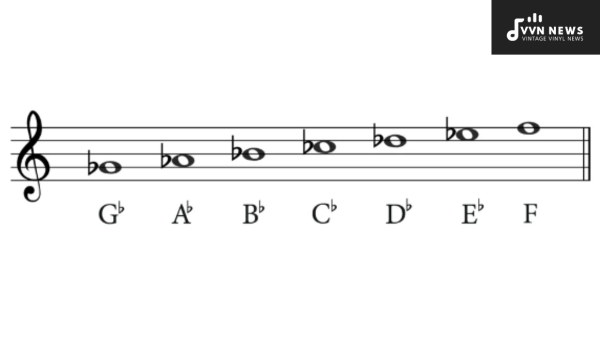Chords are the building blocks of music, and understanding them is crucial for any musician or songwriter.
In this article, we will delve into the world of chords in G Flat Major. Whether you are a beginner or an experienced musician looking to expand your chord vocabulary, this guide will provide you with a comprehensive understanding of G Flat Major chords.
To fully grasp the concept of G Flat Major chords, it’s important to have a basic knowledge of music theory.
In the musical alphabet, G Flat (also known as F Sharp) is the seventh step when counting down from C.
It may seem like an uncommon key, but it has its place in various musical genres. Understanding the chords in G Flat Major can open up new creative possibilities and add depth to your compositions.
Now, let’s explore the different types of chords that make up the rich sound of G Flat Major. From major and minor chords to augmented and diminished ones, we will cover them all in this insightful guide.
By the end of this article, you’ll have a solid foundation in G Flat Major chords and be well-equipped to incorporate them into your own musical endeavors. So let’s get started with this comprehensive A Flat Major Chords Guide!
What Are the Chords in G Flat Major?
In music theory, the chords in G Flat Major are derived from the G Flat Major scale. The G Flat Major scale consists of the following notes: Gb, Ab, Bb, Cb (or B), Db, Eb, and F.
To build chords in this key, we take every other note from the scale and stack them on top of each other in thirds. This results in four main types of chords: major, minor, augmented, and diminished.
Here is a breakdown of the chords you can play in G Flat Major:
- G Flat Major (I): Built on the first note of the scale (Gb), this chord consists of Gb (the root), Bb (the major third), and Db (the perfect fifth).
- A Flat Minor (ii): Moving up to the second degree of the scale, we have A♭ minor. This chord is made up of Ab (the root), C♭ (or B) (the minor third), and Eb (the perfect fifth).
- B Flat Minor (iii): The third degree gives us a B♭ minor. It is spelled as B♭(root) – D♭(minor third) – F♭(or E) perfect fifth.
- C Flat Major (IV): The fourth degree yields a C♭ major chord with notes C♭(root)- E♭(major third)- G♭(perfect fifth).
- D Flat Major: Moving on to D flat major as our fifth-degree chord spellings are D flat(root)-F(major third)-A♭(perfect fifth).
- E flat Minor: Reciting the sixth step we have E flat minor consisting of E flat(root)-G flat(minor third)-B(flat five).
- F Diminished: Finally, arriving at the seventh degree of our scale, we have F diminished chord. It consists of F(root)-A♭(minor third)-C♭(diminished fifth).
By memorizing these chords and their respective qualities, you can easily incorporate them into your songwriting or improvisation in G Flat Major.
Also Read: G Major Scales And Chords [Expand Your Musical Understandings]
Different types of Chords in G Flat Major
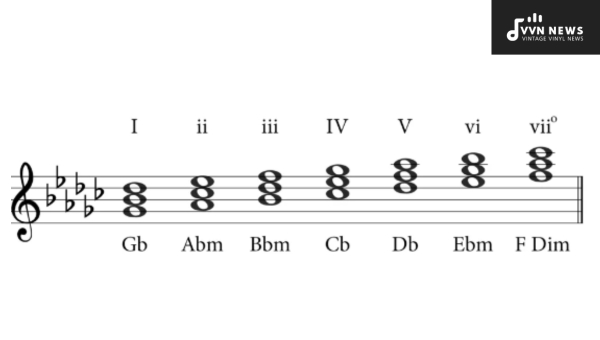
In the key of G Flat Major, there are four main types of chords: major, minor, augmented, and diminished. Each type has its own unique sound and character that can bring variety and color to your compositions.
- Major Chords: Major chords have a bright and happy sound. In G Flat Major, the major chords are built on the first (I), fourth (IV), and fifth (V) degrees of the scale. The notes in these chords follow a specific pattern of root, major third, and perfect fifth.
- Minor Chords: Minor chords have a more melancholic or sad sound compared to major chords. In G Flat Major, the minor chords are built on the second (ii), third (iii), and sixth (vi) degrees of the scale. They consist of a root note, a minor third interval above the root, and a perfect fifth interval.
- Augmented Chords: Augmented chords have a tense and unstable sound due to their raised fifth interval. In G Flat Major, you can form an augmented chord by raising the fifth of a major chord by one-half step. For example, an augmented chord built on A♭ would consist of A♭-C-E♮.
- Diminished Chords: Diminished chords have an eerie or suspenseful quality because they contain two minor thirds stacked on top of each other. In G Flat Major, diminished chords can be formed by lowering both the third and fifth intervals of a major chord by one-half step.
These different types of chords in G Flat Major open up endless possibilities for creating unique melodies and harmonies in your music compositions.
Experimenting with these chord qualities will enhance your musical creativity while adding depth to your musical arrangements.
How Do Seventh Chords Work in G Flat Major?
Seventh chords add complexity and color to the harmonies in G Flat Major. They are formed by adding an additional note, the seventh, to the triad chords we discussed earlier. The seventh can be major, minor, or diminished.
Here are the different types of seventh chords in G Flat Major and how they are constructed:
- Major Seventh (IΔ7): This chord is built on the first note of G Flat Major scale and consists of Gb, Bb, Db, and F. The major seventh interval gives it a bright and lush sound.
- Minor Seventh (ii7): Built on the second degree of the scale (Ab), this chord comprises Ab, Cb (or B), Eb, and Gb. The minor seventh adds a touch of melancholy to its sound.
- Minor Seventh (iii7): Moving up to B♭ minor as our third-degree chord spells B♭(root)- D♭(minor third)- F♭ (or E) perfect fifth- A♭(minor seventh). Strumming these notes together creates a soulful and introspective sound.
- Major Seventh (IVΔ7): The fourth degree gives us C♭ major seventh with notes Cf(root)- Ef(major third)- Gf(perfect fifth)- Bf(seventh). This chord has a smooth and dreamy quality to it.
- Dominant Seventh (V7): Moving on to D flat major as our fifth-degree chord spellings are D flat(root)-F(major third)-A♭(perfect fifth)-C(flat seven). This chord is known for its bluesy flavor.
- Minor Seventh (vi 7): Reciting the sixth step we have E flat minor seven consisting of E flat(root)-G flat(minor third)-B(flat five)-D flat(seventh). This chord adds a touch of emotional depth and tension.
- Diminished Seventh (viiø7): Finally, arriving at the seventh degree of our scale, we have F diminished seventh chord. It consists of F(root)-A♭(minor third)-C♭(diminished fifth)-E♭(minor seventh). This chord has a dissonant and unstable sound.
Seventh chords add richness and complexity to your chord progressions in G Flat Major. They can be used to create tension, resolve to other chords, or add an interesting flavor to your compositions.
Also Read: A Flat Diminished Triad [Delve Into Rare Guitar Chords]
Chord Progressions in G Flat Major
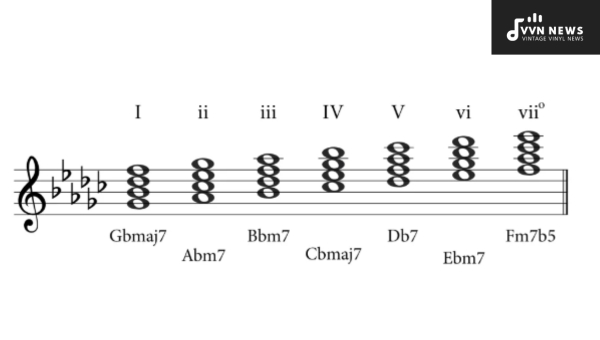
Chord progressions are a sequence of chords played in a specific order. They form the backbone of music and can evoke different emotions and moods depending on how they are structured.
In G Flat Major, there are several popular chord progressions that you can explore to create musical compositions that resonate with listeners.
Here are some common chord progressions in G Flat Major:
- I – IV – V: This classic progression is a foundation in many genres of music. In G Flat Major, it would be Gb major (I) – Cb major (IV) – Db major (V). This progression creates a sense of resolution and stability.
- vi – IV – I – V: Another popular progression is vi (Bb minor) – IV (Cb major) – I (Gb major) – V (Db major). This progression is commonly found in pop and rock music and has an uplifting and catchy feel to it.
- ii – V – I: The ii-V-I progression is commonly used in jazz music. In G Flat Major, this progression would be Ab minor (ii) – Db major (V) – Gb major (I). It creates tension and resolution, making it musically satisfying to the ear.
- iii – vi – ii – V: This progression adds more complexity and movement to your composition. In G flat Major, it would be Bb minor(F#maj7/Ab)|Ebm(Bbm9)|Abm(Db9)|Db7sus4(Cbmaj9). It creates a smooth flow from one chord to another.
- Modal Interchange: Modal interchange is a technique where chords from the parallel minor or other related keys are borrowed to add color and tension. In G Flat Major, you can experiment with borrowing chords like Cb minor, Eb minor, Bbm, or Db diminished to create interesting variations in your progressions.
- Extended Chords: Another way to enhance your chord progressions is by adding extended or altered chords. For example, you can replace a basic major chord with a major seventh (Maj7) or dominant seventh (7) chord. You can also experiment with augmented (aug) or diminished (dim) chords for added flavor.
These are just some examples of chord progressions in G Flat Major. There are countless possibilities for creating your own progressions and exploring different musical styles within this key.
Take the time to experiment, listen carefully, and let your creativity guide you as you discover new chord progressions in G Flat Major.
Also Read: A Flat Diminished Triad [Delve Into Rare Guitar Chords]
How Can Ear Training Improve Your Understanding of G Flat Major Chords?
Ear training is an essential skill for any musician. It allows you to identify and recognize different musical elements, including chords.
When it comes to G Flat Major chords, honing your ear training abilities can greatly enhance your understanding and proficiency in playing them.
- Recognizing chord qualities: With ear training, you can develop the ability to identify whether a chord is major, minor, augmented, or diminished just by listening to it. This skill will help you quickly recognize the qualities of G Flat Major chords.
- Identifying chord progressions: Ear training can help you recognize common chord progressions in G Flat Major. By listening attentively and analyzing the relationships between different chords, you’ll be able to identify common progressions such as I-IV-V or ii-V-I.
- Improvisation and composition: When improvising or composing in G Flat Major, ear training allows you to instinctively hear which chords would work well together. It enables you to explore different melodic lines and harmonies confidently.
- Transcribing music: Transcribing songs or melodies in G Flat Major can be challenging without developed ear training skills. However, with practice, you’ll be able to accurately determine the individual chords used within a piece.
By honing your ear training skills related to G Flat Major chords, you’ll gain a deeper understanding of their sounds and relationships within a musical context.
This improved awareness will enable you to play more confidently, improvise more fluently, and compose with greater creativity in this key.
Also Read: G Minor Triad [Demystify This Common Guitar Chord]
What Are the Essential Piano Chords in G Flat Major?
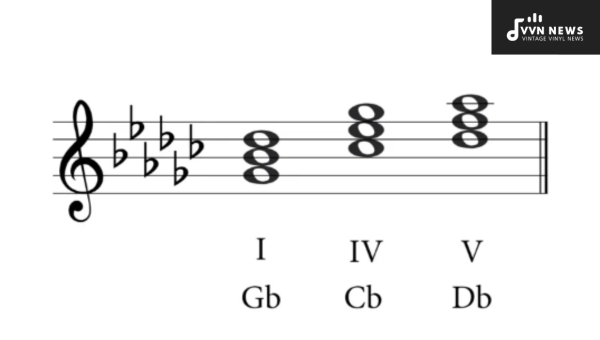
If you’re a pianist looking to explore the world of G Flat Major, mastering its essential chords will unlock a wealth of musical possibilities. Here are the essential piano chords in G Flat Major and how to play them:
- G Flat Major (I): Root notes: Gb, Bb, Db; Play left-hand Gb octave with the right hand playing Bb and Db together.
- A Flat Minor (ii): Root notes: Ab, C♭, Eb; Play left-hand Ab octave with the right hand playing C♭ and Eb together.
- B Flat Minor (iii): Root notes: B♭, D♭, F♭; Play left-hand B♭ octave with the right hand playing D♭ and F♭ together.
- C Flat Major (IV): Root notes: C♭, E♭, G♭; Play left-hand C♭ octave with the right hand playing E♭ and G♭ together.
- D Flat Major (V): Root notes: Db, F, Ab; Play left-hand Db octave with the right hand playing F and Ab together.
- E Flat Minor (vi): Root notes: Eb, Gb, B(b); Play left-hand Eb octave with the right hand playing Gb and B(b) together.
- F Diminished (vii°): Root notes: F, A(b), C(b); Play left-hand F octave with the right hand playing A(b) and C(b) together.
It’s important to note that these chords can be played in various inversions on the piano keyboard to achieve different voicings and sounds. Experimenting with different inversions will help you find the perfect sound for your musical expression.
How Do You Play Guitar Chords in G Flat Major?
Playing guitar chords in G Flat Major can be a bit challenging due to the complexity of the key, but with practice and perseverance, you’ll be able to master it. Here’s a step-by-step guide on how to play guitar chords in G Flat Major:
- Tuning: Make sure your guitar is properly tuned to standard tuning (E A D G B E).
- Barre Chords: Barre chords are commonly used when playing in G Flat Major. They involve using one finger to press down multiple strings on the same fret. Start by mastering your barre technique.
- Learn the Basic Chords: Begin by learning and memorizing the basic open position chords for G Flat Major – Gb, Abm, Bbm, Cb, Db, Ebm, Fdim.
- Use Chord Charts: Utilize chord charts or diagrams as visual references to help you remember and play the chord shapes correctly.
- Chord Transposition: If you find it challenging to play barre chords or certain positions in G Flat Major, try transposing the chords to a different position that is more comfortable for your hand.
- Finger Placement: Take note of the finger placement for each chord and ensure that you are pressing down on the strings firmly and accurately.
- Practice Smooth Transitions: Practice transitioning smoothly between chords in various progressions within G Flat Major.
- Use a Metronome: Use a metronome or drum machine to practice playing chord progressions in time with a steady beat.
Remember that consistency and practice are key when learning any new skill on the guitar. Gradually increase your speed and accuracy as you become more comfortable with playing guitar chords in G Flat Major.
What Are Chord Inversions and How Do They Apply to G Flat Major?
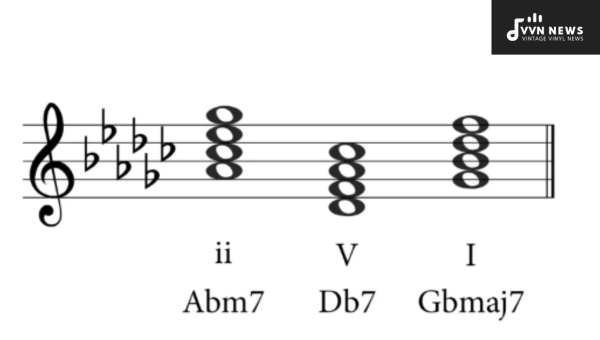
Chord inversions are different ways of playing a chord by changing the order of its notes. Inversions offer a fresh perspective on familiar chords and can add variety to your music. Instead of playing the root note as the lowest note, you can play the third or fifth as the lowest note, creating a unique sound.
In G Flat Major, chord inversions can be particularly useful for smooth and seamless transitions between chords in a progression. By using inversions, you can create smoother voice leading and avoid large jumps between notes.
To apply inversions to G Flat Major chords, follow these steps:
- Start with the basic chord: Let’s take the Gb major chord (Gb-Bb-Db). This is known as the root position.
- First inversion (3rd in bass): Move the lowest note (Gb) up an octave. The new order becomes Bb-Db-Gb.
- Second inversion (5th in bass): Take the first inversion and move its lowest note (Bb) up an octave. The new order becomes Db-Gb-Bb.
By experimenting with different inversions, you can add depth and interest to your chord progressions in G Flat Major. Remember to practice playing these inversions smoothly to enhance your musicality and improvisational skills.
Also Read: G Flat Minor Triad [Mastering Complex Guitar Chords]
FAQs about Chords in G Flat Major
What are the different types of chords in G Flat Major?
In G Flat Major, you can find major, minor, augmented, and diminished chords as the main types.
How do I play guitar chords in G Flat Major?
To play guitar chords in G Flat Major, you will need to learn the specific fingerings for each chord. It may take some practice to get comfortable with the finger positions.
How do seventh chords work in G Flat Major?
Seventh chords add an extra layer of complexity by adding a seventh note to the triad chord. In G Flat Major, these seventh chords will follow the same pattern as major, minor, augmented, and diminished chords.
What chord progressions are commonly used in G Flat Major?
Common chord progressions in G Flat Major include I-IV-V (G Flat Major-Cb Major-Db Major), ii-V-I (Ab minor-Db Major-Gb Major), and vi-ii-V-I (Eb minor-Ab minor-Db major-Gb major).
How can ear training improve my understanding of G Flat Major chords?
Ear training exercises can help train your ears to identify and recognize different chord qualities within the context of G Flat Major. This can ultimately enhance your ability to play by ear and create harmonically interesting compositions.
Conclusion
Understanding the chords in G Flat Major can greatly enhance your music composition and improvisation skills.
By familiarizing yourself with the G Flat Major scale and its corresponding chords, you can create rich and captivating musical arrangements.
Whether you’re a pianist, guitarist, or any other musician, incorporating these chords into your playing will unlock new possibilities and add depth to your musical creations.
So start exploring the world of G Flat Major chords today and let your creativity soar.
